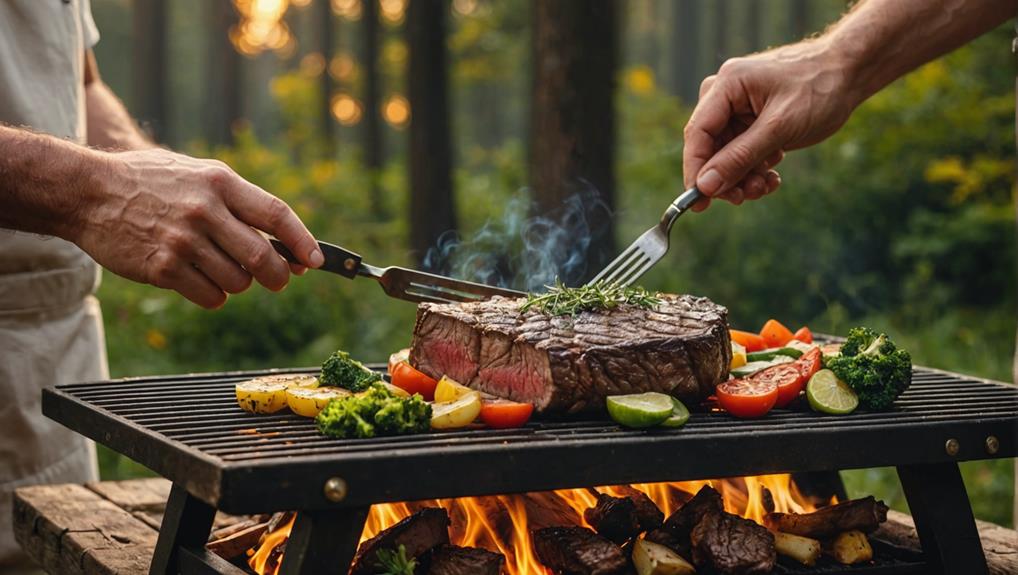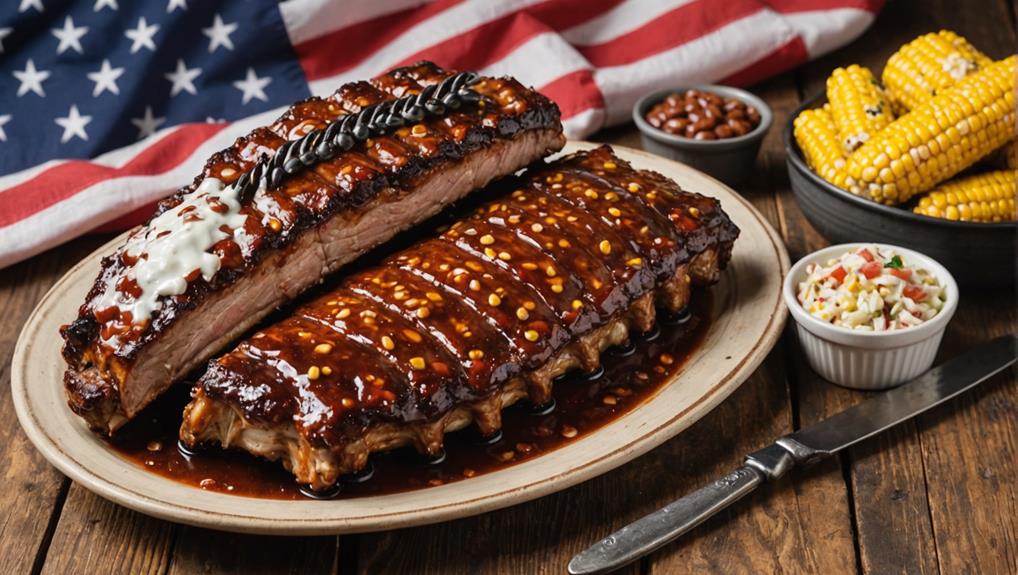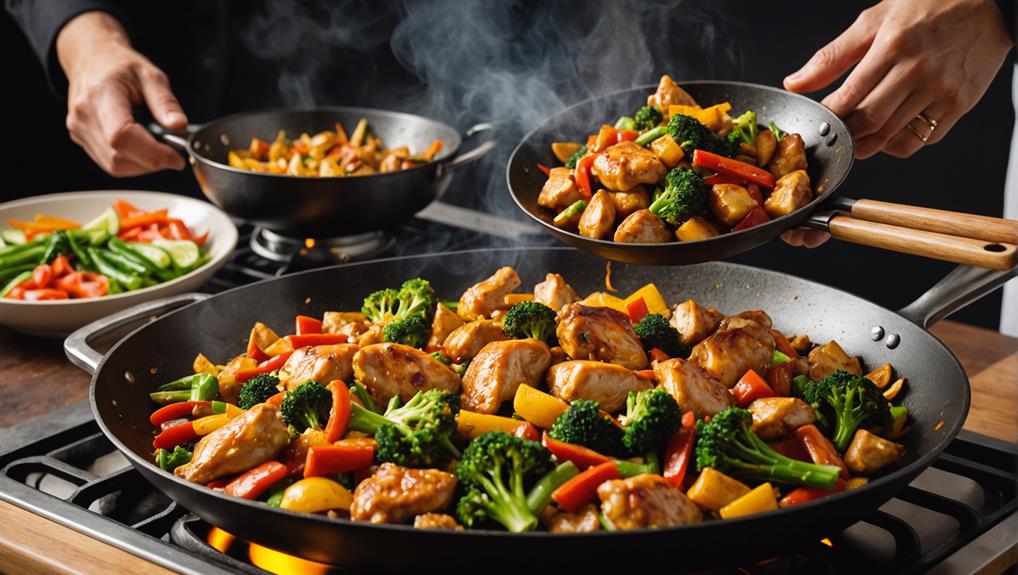To master outdoor cooking, start by equipping yourself with essential tools like a quality spatula, tongs, and a reliable meat thermometer. Prepare your grill properly, creating distinct heat zones for versatile cooking. Control temperature precisely, using digital thermometers and adjusting fuel types as needed. Enhance flavors with wood smoke and well-crafted marinades. Perfect your skewer techniques for even cooking, and always prioritize safety with proper distance from flammables and regular equipment maintenance. Learn to gauge meat doneness through temperature guides and visual cues, allowing for crucial resting time. These fundamental skills will elevate your grilling game, transforming you into a true outdoor cooking maestro.
Essential Grilling Tools
Equipped with the right tools, outdoor grilling becomes a breeze. To elevate your cooking game, you'll need a set of essential grilling tools that'll transform you into a master of the flame.
Start with a high-quality metal spatula, designed to withstand intense heat and effortlessly flip burgers or delicate fish without damaging your grill's surface. Pair this with spring-loaded tongs for a secure grip on meats and vegetables, preventing burns and ensuring precise control.
For smaller items like cut vegetables or shrimp, invest in a grill basket to keep them from falling through the grates. Temperature control is crucial, so don't forget a reliable meat thermometer to accurately gauge internal temperatures and prevent foodborne illnesses.
Finally, protect your hands with heat-resistant gloves when handling hot grates or adjusting food on the grill.
These innovative tools will revolutionize your outdoor cooking experience, allowing you to grill with confidence and precision. By incorporating these essential grilling tools into your arsenal, you'll be well-equipped to tackle any culinary challenge that comes your way, impressing your guests with perfectly cooked dishes every time.
Grill Preparation Techniques
Now that you've got your grilling tools ready, it's time to focus on proper grill preparation. As an aspiring grill master, mastering these techniques will elevate your outdoor cooking game.
Start by preheating your grill for 15-25 minutes, creating the perfect environment for juicy, stick-free results. Additionally, consider incorporating flavors from dishes like Coconut Curry Shrimp to inspire your grilling adventures. While it's heating up, ensure your grates are spotless and well-oiled, promoting better searing and easy food release.
To take your skills to the next level, divide your grill into heat zones. This innovative approach allows for versatile cooking methods, from high-heat searing to gentle, indirect cooking for thicker cuts.
Don't forget to arm yourself with a reliable meat thermometer, guaranteeing safe and perfectly cooked meats every time.
Regular maintenance is crucial for optimal performance and safety. Inspect your grill thoroughly, checking gas connections or ensuring your charcoal is additive-free.
Temperature Control Mastery
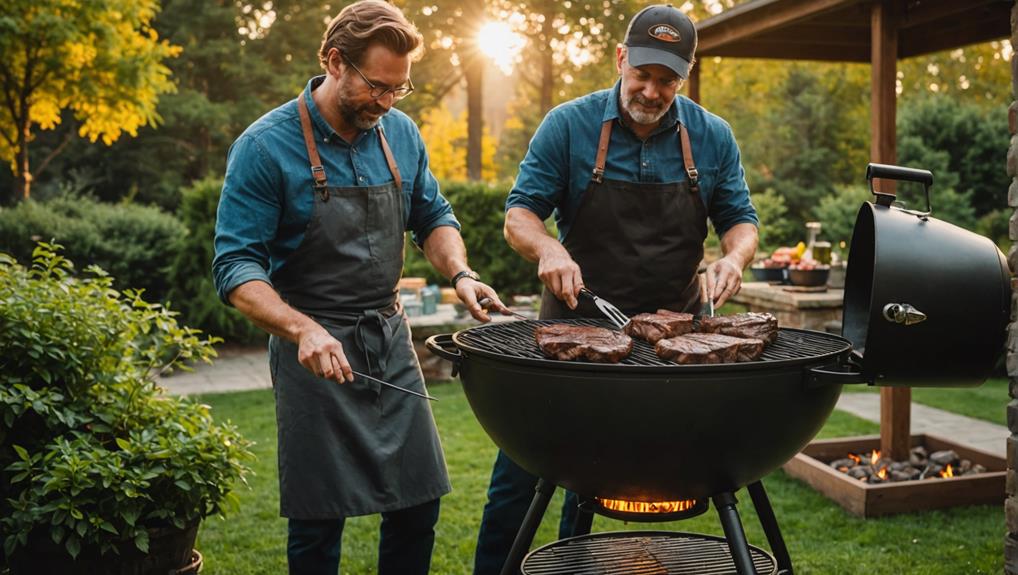
To master temperature control in outdoor cooking, you'll need to understand how to manage precise heat zones, utilize digital thermometers effectively, and select the right fuel for your needs.
Creating distinct areas of high and low heat on your grill or plancha allows you to cook different foods simultaneously at their ideal temperatures.
Your digital thermometer will become your most trusted tool, providing accurate readings of both the cooking surface and your food's internal temperature, ensuring perfect results every time.
The type of fuel you choose, whether charcoal, wood, or gas, will significantly impact your ability to control and maintain consistent temperatures throughout the cooking process.
Precise Heat Zone Management
Mastering precise heat zone management is the key to outdoor cooking success. To achieve this, you'll need to harness the power of temperature control across different sections of your grill or plancha.
Create high heat zones for searing meats and lower heat areas for delicate foods, allowing you to cook diverse dishes simultaneously with optimal results. Additionally, consider pairing your grilled meals with refreshing treats like Blueberry Lemonade Popsicles to cool down on hot days.
Begin by preheating your cooking surface for 10-15 minutes to ensure even heat distribution. This crucial step sets the foundation for consistent cooking.
Next, establish specific temperature settings: aim for high heat (450°F-500°F) when cooking meats and lower temperatures (200°F-250°F) for fish. These targeted ranges will enhance your cooking process and prevent overcooking.
Employ a meat thermometer to monitor internal temperatures precisely, ensuring safe consumption without sacrificing flavor. For example, pork should reach 145°F, while poultry requires 165°F.
To further elevate your outdoor cooking game, use high-smoke point oils like vegetable or grapeseed oil. These oils, combined with your well-managed heat zones, will enhance flavors and prevent sticking, allowing you to create culinary masterpieces with ease and precision.
Digital Thermometer Essentials
A digital thermometer is your secret weapon for outdoor cooking success. This innovative tool provides accurate temperature readings within seconds, ensuring your meats are perfectly grilled to safe internal temperatures. With a digital thermometer, you'll never have to guess if your poultry has reached 165°F or if your fish is done at 145°F.
Many models feature backlit displays, making them ideal for evening cookouts. You'll appreciate the instant-read technology, allowing you to check temperatures quickly without extended waiting times.
For the tech-savvy griller, wireless or Bluetooth-enabled thermometers can send alerts to your smartphone when your food reaches the desired temperature, freeing you up to mingle with guests.
To maintain accuracy, regularly calibrate your digital thermometer. An uncalibrated device can lead to undercooked or overcooked food, compromising both safety and flavor.
Fuel Selection Impacts
When it comes to temperature control mastery, fuel selection plays a pivotal role in outdoor cooking. Your choice of fuel can significantly impact your ability to regulate heat and achieve desired results.
Wood pellets offer steady heat and unique flavor infusion, while gas provides precise temperature control. Charcoal, though capable of reaching high temperatures quickly, demands expertise in managing airflow and fuel distribution for even cooking.
Your fuel selection also influences cooking methods. Indirect grilling with charcoal is ideal for slow-cooking meats at lower temperatures, while gas grills excel at quick searing with direct heat.
To elevate your grilling game, consider creating temperature zones by combining fuels. Adding wood chips to charcoal, for instance, allows for diverse cooking techniques within a single session.
Flavor Enhancement With Wood
The art of outdoor cooking reaches new heights when you introduce wood to the equation.
Wood pellets offer a customizable flavor enhancement experience that gas or charcoal can't match.
You'll discover a world of taste possibilities, from hickory's robust smokiness to fruit woods' subtle sweetness.
As you grill, aromatic smoke infuses your food, creating a multisensory experience that elevates your culinary skills.
One popular dish that benefits greatly from wood smoking is BBQ pulled pork, where the *smoky essence complements the rich flavors of slow-cooked pork and BBQ sauce* BBQ pulled pork sandwiches.
To master flavor enhancement with wood, consider these tips:
- Experiment with different wood types for unique flavor profiles
- Ensure even smoke distribution for consistent taste
- Control temperature precisely for optimal texture and flavor
- Combine wood types to create signature flavor blends
Skewer Cooking Perfection
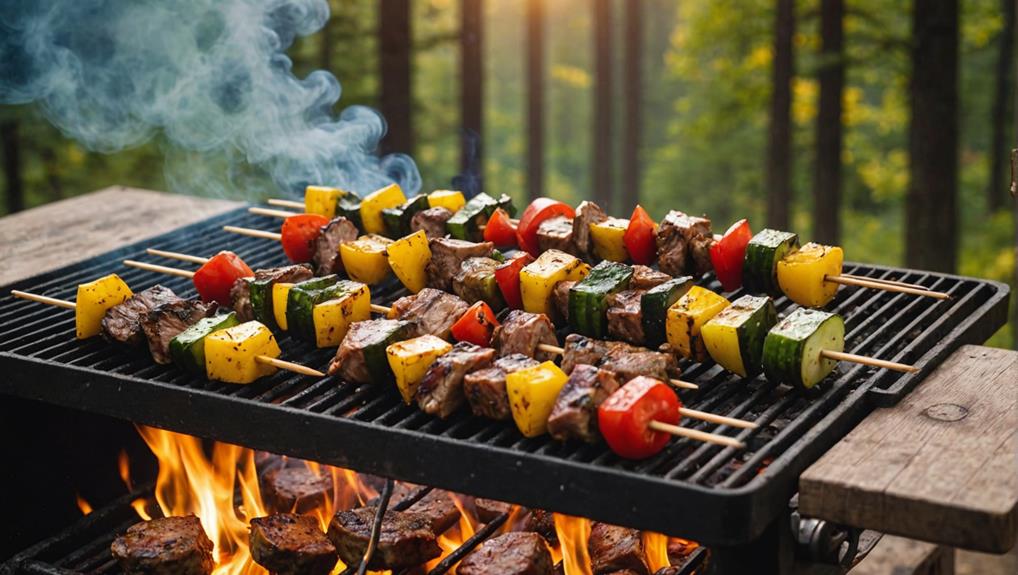
To achieve skewer cooking perfection, you'll want to start with the right tools and techniques.
Choosing the appropriate skewers, whether wooden or metal, can make a significant difference in your grilling success.
Once you've selected your skewers, it's time to focus on creating mouthwatering marinades that will infuse your kebabs with rich, complex flavors and keep them juicy throughout the cooking process.
Perfect Skewer Selection Tips
Mastering the art of skewer selection can elevate your outdoor cooking game to new heights. When it comes to grilling, the right skewers make all the difference. Opt for metal skewers for durability and even heat distribution, ensuring a consistent cooking experience without the risk of splintering.
If you prefer wooden skewers, soak them in water for at least 30 minutes before use to prevent burning and extend their lifespan. Choose flat skewers to keep your food from rotating, making it easier to flip and achieve even cooking on all sides.
Select skewers that are 10-12 inches long, providing ample space for multiple food items while allowing for easy handling. Remember to thread foods with similar cooking times together for optimal results.
To revolutionize your outdoor cooking experience, consider these innovative skewer tips:
- Experiment with dual-pronged skewers for better food stability
- Try color-coded skewers to differentiate between meat and vegetable options
- Invest in adjustable-length skewers for versatility in cooking different food sizes
- Explore skewers with built-in food stoppers for precise spacing and even cooking
Marinades for Flavorful Kebabs
Flavor explosion awaits when you master the art of kebab marinades. To elevate your grilling game, start with the perfect ratio: 3 parts oil to 1 part acid. This combination ensures your skewer ingredients remain moist and packed with flavor.
For innovative marinades, experiment with yogurt-based mixtures. They're not just for tang; the lactic acid tenderizes dense meats like chicken or lamb, transforming them into succulent bites.
Don't shy away from bold flavors. Incorporate fresh herbs, spices, and seasonings to create unique profiles. Try cilantro, garlic, and cumin for a zesty kick that'll impress your guests.
Remember, marinade magic takes time. Allow at least 30 minutes for the flavors to infuse and tenderize your chosen ingredients. Before skewering, let excess marinade drip off to prevent flare-ups and ensure even cooking without burnt edges.
For the best results, balance your acidic components carefully. Vinegar or citrus juice will tenderize the meat, but too much can overpower. Aim for harmony in your marinade, and you'll unlock a world of flavors that'll make your kebabs the talk of the neighborhood.
Effortless Food Handling
Outdoor chefs know that effortless food handling is key to a successful cookout. To master the art of outdoor cooking, you'll need the right tools and techniques.
Use metal spatulas and dedicated tongs to maneuver food on a plancha, preventing damage to non-stick surfaces while ensuring efficient cooking. For grilling, employ grill baskets to keep smaller items from falling through the grates and achieve even cooking.
Preheating your plancha for 10-15 minutes creates a searing effect that locks in flavors and moisture. Utilize different heat zones on the cooking surface, placing items that need longer cooking times in cooler areas while searing meats and vegetables in hotter zones.
After cooking, allow food to rest briefly to retain juices, enhancing flavor and texture.
To effortlessly handle food during your outdoor cooking adventures:
- Use metal spatulas and tongs for planchas
- Employ grill baskets for smaller items
- Preheat cooking surfaces for optimal results
- Utilize different heat zones for varied cooking times
Efficient Charcoal Ignition
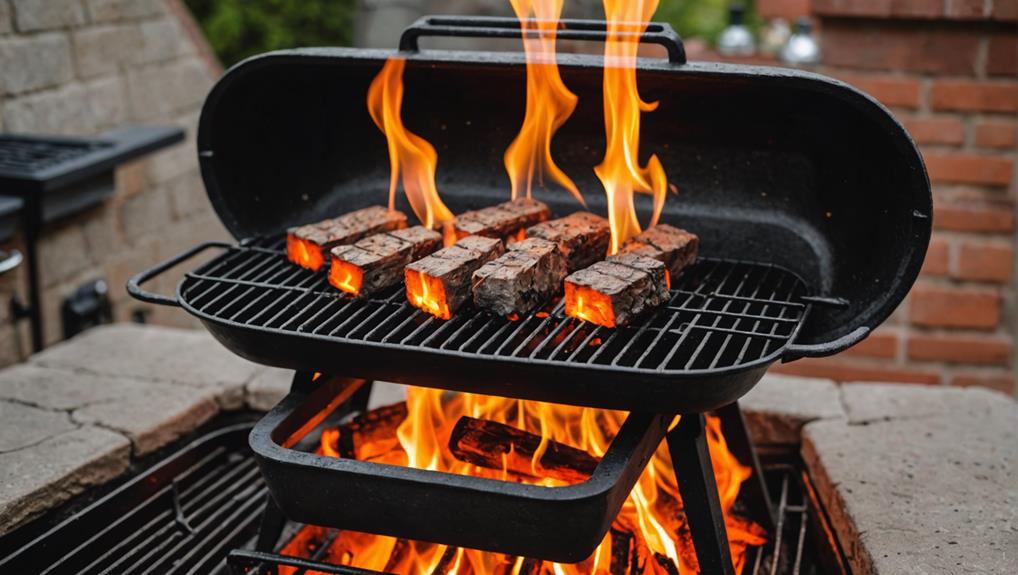
Three key elements are essential for efficient charcoal ignition: proper equipment, technique, and patience.
To revolutionize your charcoal grilling experience, start by investing in a chimney starter. This innovative tool eliminates the need for lighter fluid, ensuring a cleaner burn and faster ignition. For optimal results, pre-soak your natural charcoal briquettes for 20-30 minutes, enhancing their flammability and reducing ignition time.
Next, master the art of charcoal arrangement. Create a pyramid shape to maximize airflow, promoting faster and more consistent heating. At the base of your chimney starter, incorporate crumpled newspaper or dry kindling to ignite the charcoal without chemical accelerants. This eco-friendly approach not only improves flavor but also aligns with modern sustainability practices.
Maintaining proper ventilation is crucial for achieving the ideal burning temperature. Keep your grill's vents open to promote airflow throughout the cooking process.
By following these innovative techniques, you'll transform your charcoal grilling experience, achieving efficient charcoal ignition that sets the stage for perfectly cooked outdoor meals.
Embrace these methods to elevate your grilling game and impress your guests with your newfound expertise.
Grilling Safety Precautions
While mastering efficient charcoal ignition is key to great grilling, prioritizing safety is equally important. When it comes to grilling safety precautions, you'll want to keep a few crucial points in mind.
First, always maintain a safe distance of at least 10 feet between your grill and any flammable materials. This simple step can prevent accidental fires and protect your outdoor space.
Next, equip yourself with long-handled tools and heat-resistant gloves to minimize burn risks while handling hot equipment or food.
To ensure both safety and culinary success, follow these essential tips:
- Monitor grill temperature carefully and use a meat thermometer for safe internal temperatures
- Check propane connections regularly for leaks using soapy water
- Keep a first aid kit nearby for quick response to potential injuries
- Use long-handled tools and heat-resistant gloves for safer handling
Meat Doneness Precision
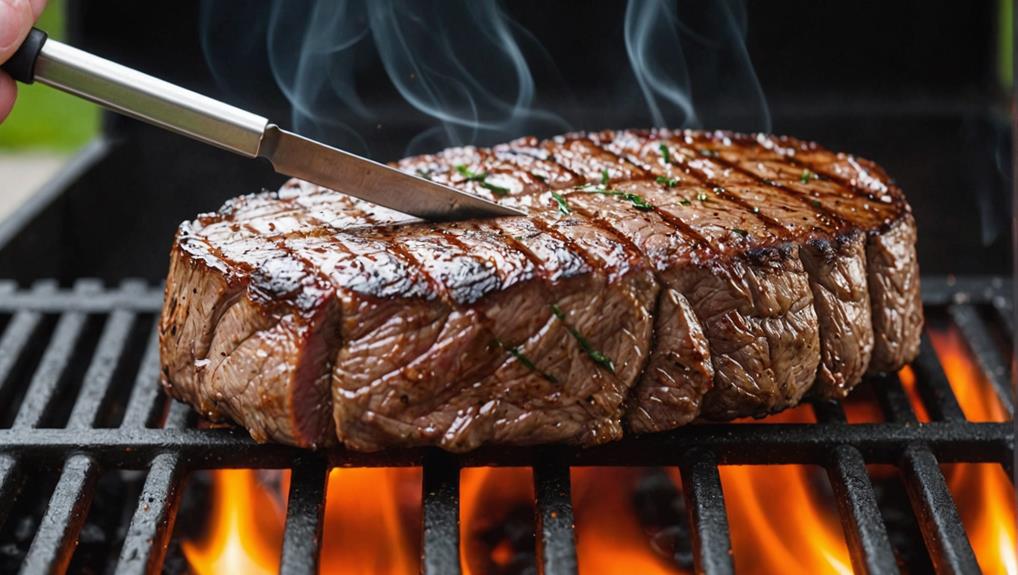
To achieve meat doneness precision in outdoor cooking, you'll need to familiarize yourself with temperature guides for different cuts and visual cues that indicate proper cooking.
Remember, internal temperatures range from 145°F for medium-rare beef to 165°F for poultry, and using a meat thermometer is the most reliable method to ensure food safety.
Once your meat reaches the desired temperature, don't forget to let it rest, allowing juices to redistribute and enhance flavor—aim for at least 3 minutes for smaller cuts and up to 20 minutes for larger ones.
Temperature Guide for Cuts
Achieving the perfect doneness for your outdoor-grilled meats isn't just about timing; it's about precision. To truly Master the Art of outdoor cooking, you'll need a reliable temperature guide for cuts.
Let's dive into the specifics for various meats to ensure you're serving up perfection every time.
For beef steak, your target temperatures range from 125°F for rare to 170°F for well-done. Pork requires a minimum of 145°F, followed by a crucial three-minute rest. When it comes to chicken breasts, aim for 165°F to guarantee both safety and tenderness. Ground meats need to hit 160°F to minimize health risks. For lamb lovers, 135°F delivers medium-rare succulence, while 160°F yields a solid medium.
To elevate your grilling game:
- Invest in a high-quality meat thermometer
- Create a temperature cheat sheet for quick reference
- Practice temperature checks on different cuts
- Experiment with resting times to fine-tune juiciness
Visual Cues for Doneness
The art of grilling extends beyond temperature readings to include a keen eye for visual cues. To achieve that perfect sear and optimal doneness, you'll need to master the art of observation.
For beef, watch as the color transforms from red to pink to brown, indicating rare, medium, and well-done respectively. You'll also notice a change in texture; raw meat feels soft and squishy, while properly cooked cuts become firmer with a slight bounce.
Pay attention to the juices as well. Clear juices in poultry signal it's fully cooked, while red or pink juices in beef suggest it may need more time. Remember, thicker cuts require extra vigilance. Check the thickest part to ensure uniform doneness throughout.
While visual cues are invaluable, don't forget to complement them with a meat thermometer for precision. Ground meat should reach 160°F, and poultry 165°F for safety.
Resting Time Importance
Visual cues are just the beginning of perfecting your grilled meats. To truly elevate your outdoor cooking game, you'll need to master the art of resting time.
This crucial step allows juices to redistribute throughout the meat, enhancing both flavor and tenderness. Don't rush to slice into that beautifully seared steak; patience is key. Resting time can prevent up to 30% juice loss, ensuring your meat remains succulent and mouthwatering.
Here's what you need to know about resting time:
- Smaller cuts like steaks need 5-10 minutes
- Larger roasts require 15-20 minutes
- Internal temperature can rise 5-10°F during resting
- Use a meat thermometer for precise doneness
Cleaning and Maintenance Tips
Proper cleaning and maintenance are crucial for keeping your outdoor cooking equipment in top shape. After using your plancha or grill, always let it cool completely before starting the cleaning process. This ensures your safety and prevents damage to the surface.
Once cooled, use scrapers or spatulas to remove food debris effectively. Avoid using soaps or abrasive cleaners, as they can harm the non-stick surface. Instead, wipe down the cooking space with a damp cloth to remove residue. For tough stains or grease, a vinegar solution can work wonders.
To maintain proper functionality and prevent flare-ups, regularly inspect and clean grease trays and drip pans.
After heavy use, schedule a deep cleaning session. This should include thorough scrubbing of grates and replacement of any worn-out components.
Frequently Asked Questions
What Is the Outdoor Cooking Challenge Show?
You'll love the Outdoor Cooking Challenge Show! It's a thrilling competition where contestants showcase innovative grilling techniques and master outdoor flavors. You'll witness culinary creativity unfold as chefs battle nature's elements to impress discerning judges.
Final Thoughts
You've now unlocked the secrets to becoming a grill master, ready to turn your backyard into a culinary oasis. Armed with these techniques, you'll confidently handle any outdoor cooking challenge. Remember, practice makes perfect, so don't be afraid to experiment. As you hone your skills, you'll soon be serving up mouthwatering feasts that'll have your guests singing your praises. So fire up that grill, and let your newfound expertise sizzle on the plates of eager diners.

